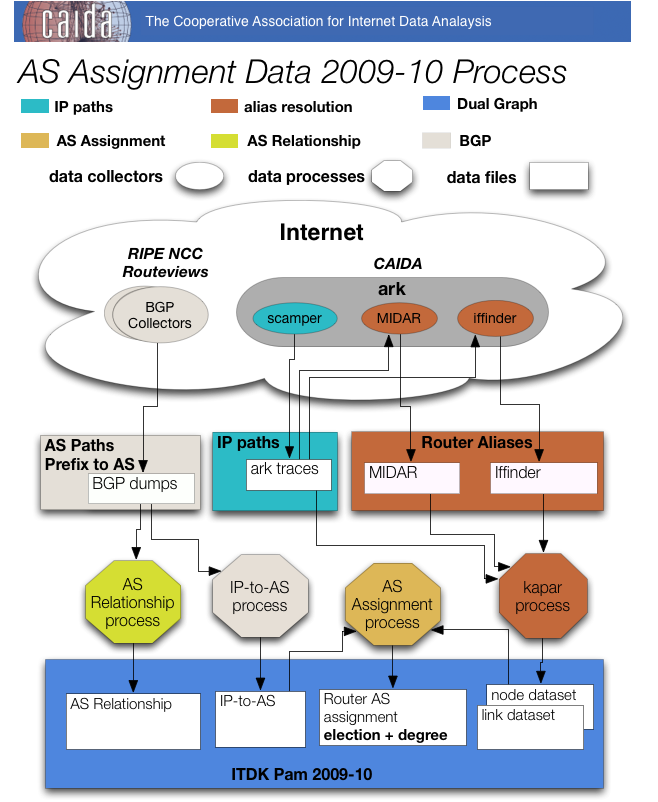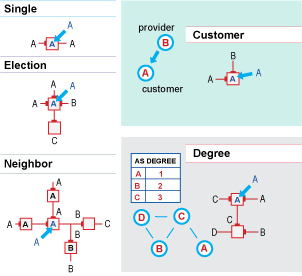Toward Topology Dualism: Improving the Accuracy of AS Annotations for Routers

Active measurement data
We collected our active measurements using CAIDA's Archipelago (Ark) measurement infrastructure. In October 2009 when we gathered the measurements for the PAM2010 paper, the Ark infrastructure had 37 monitors in 28 countries. These monitors used Paris traceroute to probe randomly chosen destinations from each routed /24 prefix seen in BGP dumps from Routeviews over a 28-day collection period in September and October 2009. We call the resulting set of 268 million traceroute paths our traceroute dataset, which we use to infer which IP interfaces belong to the same router, a process known as alias resolution.
Alias resolution
For alias resolution, we rely on several CAIDA tools: iffinder, kapar, and MIDAR, (recent tech report). MIDAR (Monotonic ID-based Alias Resolution, a tool we hope to release by April 2010) expands on the IP velocity techniques of RadarGun, while kapar expands the analytical techniques of APAR. We use the traceroute dataset as input to MIDAR and iffinder, which generate output files used as input to kapar. kapar heuristically infers the set of interfaces that belong to the same router, and the set of two or more routers on the same ``IP link'' (a construct that represents either a point-to-point link, or LAN or cloud with multiple attached IP addresses). kapar correctly identified 66% of the true aliases from our ground truth dataset, with a 5% false positive rate.
BGP data
To assign IP addresses to ASes, we used publicly available BGP dumps provided by Routeviews and one of RIPE NCC's collectors (RCC12) in October 2009. BGP (Border Gateway Protocol) is the protocol for exchanging interdomain routing information among ASes in the Internet. A single origin AS typically announces ("originates") each routable prefix via BGP. We perform IP-to-AS mapping by assigning an IP address to the origin AS of the longest matching prefix for that IP address in the BGP tables.
AS relationships
We used the BGP data to annotate each interdomain link with one of three simplified business relationships -- customer-provider (the customer pays the provider), settlement-free peer (typically no money is exchanged), and sibling (both ASes belong to the same organization) -- using the classification algorithm by Dimitropolous, et al., resulting in what we call the AS relationship dataset.
AS assignment

The goal of the AS assignment process is to determine the AS that owns each router. For each router r, we first create an AS frequency matrix that counts the number of interfaces (known and inferred) from each AS that appears on r. The ASes in this frequency matrix represent the set of possible owner ASes of r. We use the following AS assignment heuristic to assign a router r to an AS.
The Election heuristic assigns router r to the AS with the highest frequency in r's AS frequency matrix. The intuition behind this heuristic is that routers will tend to have more interfaces in the address space of their owner. If two ASes from r's AS frequency matrix have the same count, then Election cannot decide an owner.
The Customer heuristic uses the AS relationship dataset to assign relationships to each pair of ASes from r's AS frequency matrix. Customer assigns r to the AS inferred to be a customer of every other AS in r's AS frequency matrix. This heuristic is based on the common practice that customer and provider routers typically interconnect using addresses from the provider's address space. Consequently, a router with interfaces from both the customer and provider address spaces is assigned to the customer.
For the Degree heuristic, we first generate an AS-level graph by assuming full-mesh connectivity among ASes from each router's AS frequency matrix. We then use this graph to generate an AS degree for each AS. Degree assigns router r to the smallest-degree AS from r's AS frequency matrix, i.e., the AS most likely to be the customer AS, based on similar intuition as the Customer heuristic.
For the Neighbor heuristic, we first determine the set of single-AS routers to which r is connected (its single-AS neighbors). We create a new AS frequency matrix that counts the number of single-AS neighbors of r from each AS. The Neighbor heuristic assigns r to the AS with the largest frequency (most single-AS neighbors), based on the intuition that a router is connected to a larger number of single-AS routers in its owner AS. Neighbor produces an ambiguous assignment when multiple ASes have the same (highest) frequency.
In case one of the previously described primary heuristics is unable to produce an AS assignment, we attempt to break the tie using one of the other heuristics as a tiebreaker. Our evaluation in the paper shows that Neighbor was the best stand-alone heuristic, while Election+Degree was the best combination.
PAM 2009-10 dataset
The following datasets constitute the dual-graph representation of the Internet using data collected in October 2009:
- nodes.20091006.gz (node
dataset) is the set of routers inferred by kapar. For
each router, the node dataset contains the set of interfaces
that were inferred as being on that router.
File format:
node <node_id>: <i1> <i2> ... <in>indicates that kapar inferred the node with id node_id to have the n interfaces i1 to in
-
links.20091006.gz (link dataset) contains, for each link, the set of
routers and router interfaces that kapar inferred as sharing
that link.
File format:
link <link_id>: <N1>:i1 <N2>:i2 [<N3>:[i3]] ... [<Nm>:[im]]indicates that kapar found a link link_id connecting nodes N1 to Nm. Note that kapar always determines at least two nodes and the associated interfaces for each link. There may, however, be additional nodes on the same link due to the presence of LANs or clouds with multiple attached interfaces.By joining the node and link datasets, one can obtain for each node a set of known interfaces and inferred interfaces. Known interfaces were measured directly and are in the node dataset; Inferred interfaces result from entries in the link dataset that indicate that node N1 has a link to interface i2 on node N2, but we did not see an actual interface on node N1. The interfaces on an IP link are typically assigned IP addresses from the same prefix, so we assume that node N1 must have an inferred interface from the same prefix as i2.
-
prefix2as.20091006.gz (IP-to-AS) contains the list of IP prefix to origin AS
found in the BGP dumps.
File format:
<prefix> <length> <origin AS>When multiple ASes were found as the origin of the same prefix, they are concatenated with an underscore.
-
nodes.as.20091006.gz (AS assignment
dataset) contains, for each node found in the
node dataset, the AS that is the inferred owner of that
node according to to our final Election+Degree
assignment heuristic.
File format:
<node_id> <AS> <method>
-
as-rel.a0.01000.20091020.gz (AS relationship dataset) contains the business
relationship associated with each link in the BGP data, computed
(see above) using the AS relationships algorithm by
Dimitropolous, et al.
File format:
<AS1> <AS2> <rel>
where
rel is -1 if AS1 is a customer of AS2
rel is 1 if AS1 is a provider of AS2
rel is 0 if AS1 is a peer of AS2
rel is 2 if AS1 is a sibling of AS2
AS Assignment code
- The RouterToAsAssignment utility is our current implementation of the Degree+Election code.

